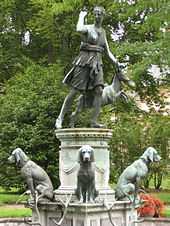Diana of Versailles

The Diana of Versailles is a slightly over lifesize[1] marble statue of the Greek goddess Artemis (Latin: Diana), with a deer, located in the Musée du Louvre, Paris. It is a Roman copy (1st or 2nd century AD) of a lost Greek bronze original attributed to Leochares, c. 325 BC.
The statue is also known as Diana à la Biche, Diane Chasseresse ("Diana Huntress"), Artemis of the Chase, and Artemis with the Hind.
The statue was discovered in Italy: the Louvre website suggests Nemi, where there was an ancient sanctuary; other sources [citation needed] posit Hadrian's Villa at Tivoli; in 1556[2] it was given by Pope Paul IV to Henry II of France, with a subtle but inescapable allusion to the king's mistress, Diane de Poitiers. It was installed as the central feature of the Jardin de la Reine laid out west of the Galerie des Cerfs at Fontainebleau; there it was the most prominently displayed and among the first Roman sculptures to be seen in France. "Alone amongst the statues exported from Italy before the second half of the seventeenth century the Diane Chasseresse acquired a reputation outside Italy equivalent to the masterpieces in the Belvedere or the Villa Borghese",[3] though its admirers generally confused it with the Artemis of Ephesus.[4] In 1602 Henri IV removed it to the Palais du Louvre, where the Diana was installed in a specially designed gallery to receive it, the Salle des Antiques (now the Salle des Caryatides. At the time its restorations were revised by Barthélemy Prieur. Replacing it at Fontainebleau was Prieur's bronze replica cast from it in 1605 (Haskell and Penny 1981:196), which was set upon a high Mannerist marble pedestal arranged by the hydraulics engineer Tommaso Francini, with bronze hunting dogs and stag's heads spitting water by Pierre Briard, 1603, in a parterre surrounded by an orangery[5] Another full-size bronze replica was made in 1634 by Hubert Le Sueur for Charles I of England, the brother-in-law of Louis XIII.[6]
The Diana was installed in the Grande Galerie of Versailles by Louis XIV. For Marly a marble copy was executed by Guillaume Coustou in 1710.
As one of France's greatest treasures, the Diane Chasseresse returned to the Louvre in An VI of the First Republic (1798).[7] It was restored once more, in 1802, by Bernard Lange.[8]

Diana is represented as a slender and masculine huntress, attended by a smaller than life buck (male deer) in vibrancy of life. She looks toward the right, perhaps towards the very deer, as with raised right arm she draws an arrow from the quiver. Her left hand can be seen to be holding the part of a bow, the remainder missing, in position for striking; the missing bow transforming the image into a simple pastoral one from one symbolic of huntress and prey. She wears a short Dorian chiton, a himation around her waist, and sandals.
Comparable Roman replicas of the same model, noted by the Louvre's website, have been found at Leptis Magna (Libya) and at Antalya (Turkey).
A miniature replica of the statue stood on the fireplace mantle in the Titanic's first class lounge. In 1986, Robert Ballard discovered and photographed the statue on the sea floor near the bow section of the wreck.
Notes
- ↑ The statue stands 2.01 meters in height.
- ↑ Date according to the Musée du Louvre on-line catalogue.
- ↑ Francis Haskell and Nicholas Penny, Taste and the Antique: the Lure of Classical Sculpture, 1500-1900 1981:196.
- ↑ The error was forcefully refuted by Jean-Aymar Piganiol de La Force, Nouvelle description des châteaux et des parcs de Versailles et de Marly (Paris, 1713), Haskell and Penny note (1981:196).
- ↑ The orangerie was swept away under Louis-Philippe. In 1813 the present bronze, a replica dated 1684, replaced Prieur's, which was moved into the Galerie des Cerfs.
- ↑ It is now at Windsor Castle.
- ↑ Accession number 589.
- ↑ Lange is also credited with the first restorations to the Venus de Milo
References
- Maxime Collignon, Manual of Mythology, in Relation to Greek Art, H. Grevel & Co., 1890. Page 94.
- Francis Haskell and Nicholas Penny, 1981. Taste and the Antique: The Lure of Classical Sculpture 1500-1900 (Yale University Press) Cat. no. 30.
- Martin Robertson, 1975. A History of Greek Art (Cambridge University Press) vol. I, pp 460–61
External links
| Wikimedia Commons has media related to Diana of Versailles. |
- Diana of Versailles
- (Musée du Louvre) Artémis à la biche, dite "Diane de Versailles"
- Château de Fontainebleau: Le Jardin de Diane